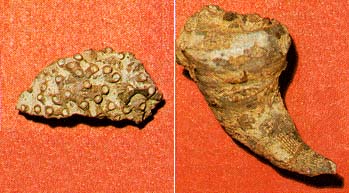
Ancient Life in Kansas Rocks, part 8 of 27
In this next photograph (slightly enlarged) are two fossil corals. Corals are simple animals resembling sea anenomes but they secrete a calcareous shell for protection and support. Some of these, such as the horn coral at the right, are large and grow in a solitary fashion. They have complex internal structure, partly revealed near the base of the specimen where the outer wall has worn away, revealing the radial partitions called septa.

Another form of coral is colonial, a simple example of which is auloporid on the left in the photo above. Lacking in internal skeletal features, each successive trumpet-shaped individual or "corralite" directly builds from its parent predecessor in a manner termed budding. Thus, a common interconnected series of organisms arises, forming a colony. The auloporid is an especially simple form of colonial coral, and one may see the small circular openings in the specimen in which was contained the indivual anemone-like polyp. (Horn coral, Lecompton Limestone, Upper Pennsylvanian; Auloporid, Beil Limestone, Upper Pennsylvanian)
Kansas Geological Survey
Placed online Feb. 1997
URL = "http://www.kgs.ku.edu/Publications/ancient/f08_corals.html"
Send comments and/or suggestions to webadmin@kgs.ku.edu